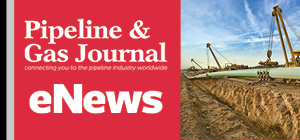414-Mile Iroquois Pipeline Expansions Clear Regulatory Hurdle in New York
By Mary Holcomb, Digital Editor
(P&GJ) — New York state officials have approved key permits for the Iroquois Enhancement by Compression (ExC) Project, advancing a 414-mile interstate natural gas pipeline expansion designed to support downstate gas reliability. The New York State Department of Environmental Conservation (NYSDEC) issued Air State Facility permits for the project's compressor station upgrades in Dover and Athens, clearing a major regulatory hurdle for Iroquois Gas Transmission System.
The ExC Project involves installing 12,000 horsepower (hp) of new compression and associated facilities at each of the existing Iroquois Dover and Athens Compressor Stations in New York. It also includes upgrades to the Milford and Brookfield stations in Connecticut. The project is designed to deliver an additional 125,000 dekatherms per day (Dth/d) of firm natural gas transportation service to two major utility customers—Consolidated Edison and National Grid.
Pipeline Route and Information
For an overview of this project and other related infrastructure developments, visit Global Energy Infrastructure.
The pipeline itself runs from the U.S.-Canada border at Waddington, New York, through New York and western Connecticut to Commack, New York, with a spur from Huntington to the Bronx. Iroquois began operations in 1992 and is operated by its wholly owned subsidiary headquartered in Shelton, Connecticut.
The expansion does not involve new pipeline construction. Instead, the additional capacity will come from compressor-only enhancements to the existing infrastructure. The Federal Energy Regulatory Commission (FERC) issued a certificate of public convenience and necessity for the ExC Project in March 2022. Air permit approval from the Connecticut Department of Energy and Environmental Protection remains pending.
NYSDEC’s review process included multiple rounds of public comment and a review of whether the project aligns with New York’s Climate Leadership and Community Protection Act (CLCPA). While NYSDEC acknowledged that the project is inconsistent with statewide greenhouse gas (GHG) emission limits, it cited a determination from the New York Department of Public Service (DPS) stating the project is necessary to ensure reliable gas supply.
"The [ExC] Project would address... existing reliability problems by both adding firm capacity into the downstate region... and providing operational flexibility in case of supply decreases from pipelines located to the south of New York City," DPS stated in a February 2024 letter.
The utilities also underscored their need for the project. In public comments filed in April 2024, National Grid stated that without the ExC Project, it anticipates a supply gap beginning in winter 2027/2028 and growing through 2050. Con Edison, in its Long-Term Gas Plan submitted in 2023, noted that the project would reduce reliance on delivered services, which are less dependable during peak demand periods.
Public Opposition and State Rebuttals
The project has drawn strong opposition from environmental groups and residents who argue that increasing natural gas infrastructure contradicts the state’s climate goals and poses public safety risks. Concerns included proximity of compressor stations to existing power plants, risks of leaks, explosions, and questions about pipeline integrity due to the system's age.
In its official response, NYSDEC acknowledged that the ExC Project would result in increased GHG emissions, particularly from downstream combustion. However, the agency justified issuing the permits under CLCPA Section 7 by incorporating mitigation measures and citing the project's reliability necessity.
Mitigation requirements in the final permits include the installation of vapor recovery systems to reduce methane emissions and minimize blowdowns, as well as six additional fugitive emissions surveys per year at the Athens and Dover sites. The agency also confirmed that the project will not increase the maximum allowable operating pressure (MAOP) of the pipeline, which remains at 1,440 pounds per square inch gauge (psig).
Responding to safety concerns, FERC noted in its Final Environmental Impact Statement that the compressor stations are sited and will be operated in accordance with U.S. Department of Transportation Pipeline and Hazardous Materials Safety Administration (PHMSA) regulations. The Athens Compressor Station is located more than 2,100 feet from the New Athens Generating power plant, while the Dover facility is approximately 3,700 feet from the Cricket Valley Energy Center.
The Iroquois Pipeline has maintained an active integrity management program since its inception, including weekly patrols and internal inspections exceeding federal requirements. Iroquois applies its integrity protocols to 100% of pipeline segments, compared to the 11% required in high-consequence areas.
While some public comments claimed the ExC Project is unnecessary due to declining gas demand, the New York DPS countered with an analysis showing utilities are over-relying on compressed natural gas (CNG) and delivered services that may not be available on the coldest days. The ExC Project, according to DPS, would reduce those risks and enhance operational flexibility.
The Author
Related News
Related News

- Enbridge Plans 86-Mile Pipeline Expansion, Bringing 850 Workers to Northern B.C.
- Intensity, Rainbow Energy to Build 344-Mile Gas Pipeline Across North Dakota
- U.S. Moves to Block Enterprise Products’ Exports to China Over Security Risk
- Strike Pioneers First-of-Its-Kind Pipe-in-Pipe Installation on Gulf Coast with Enbridge
- 208-Mile Mississippi-to-Alabama Gas Pipeline Moves Into FERC Review
- U.S. Pipeline Expansion to Add 99 Bcf/d, Mostly for LNG Export, Report Finds
- A Systematic Approach To Ensuring Pipeline Integrity
- 275-Mile Texas-to-Oklahoma Gas Pipeline Enters Open Season
- LNG Canada Start-Up Fails to Lift Gas Prices Amid Supply Glut
- Strike Pioneers First-of-Its-Kind Pipe-in-Pipe Installation on Gulf Coast with Enbridge






Comments